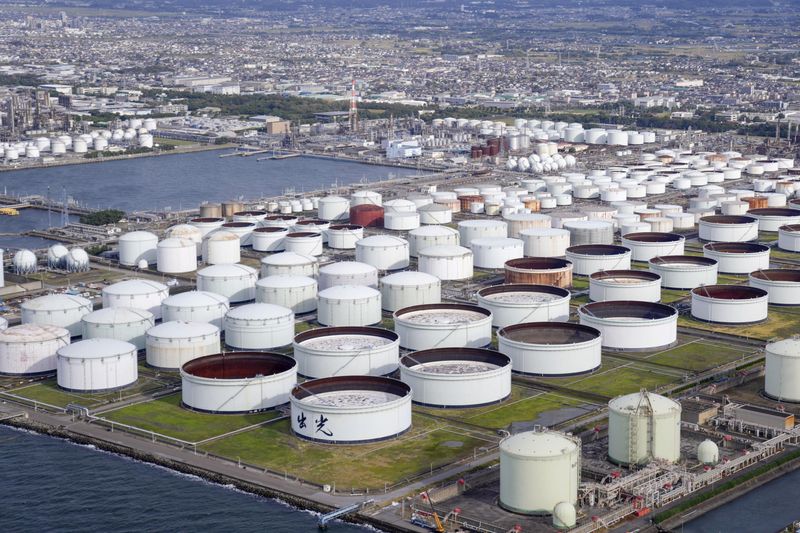Commodities
Oil heads for seven week decline for first time in five years


© Reuters. An aerial view shows an oil factory of Idemitsu Kosan Co. in Ichihara, east of Tokyo, Japan November 12, 2021, in this photo taken by Kyodo. Picture taken on November 12, 2021. Mandatory credit Kyodo/via REUTERS ATTENTION EDITORS – THIS IMAGE WAS PROVIDE
By Paul Carsten
LONDON (Reuters) -Oil benchmarks were on track for a seven-week decline on Friday, their first in half a decade, on worries about a supply surplus and weak Chinese demand, though prices rebounded after Saudi Arabia and Russia lobbied OPEC+ members to join output cuts.
futures were up $1.51, or 2%, at $75.56 a barrel at 1234 GMT, while U.S. West Texas Intermediate crude futures were up $1.42, or 2%, to $70.76 a barrel. Brent had earlier risen by $2.
Both benchmarks slid to their lowest since late June in the previous session, a sign that many traders believe the market is oversupplied. Brent and WTI are also in contango, a market structure in which front-month prices trade at a discount to prices further out.
OPEC+’s “weakening position in providing support coupled with record high US production and sluggish Chinese import figures can only mean one thing: there is an abundance of oil available, which is neatly reflected in the contangoed structure of the two pivotal crude oil benchmarks,” said Tamas Varga of oil broker PVM in a note.
Friday’s gains, meanwhile, are a “correction and nothing else,” Varga said.
Saudi Arabia and Russia, the world’s two biggest oil exporters, on Thursday called for all OPEC+ members to join an agreement on output cuts for the good of the global economy, only days after a fractious meeting of the producers’ club.
The Organization of the Petroleum Exporting Countries and allies, known as OPEC+, agreed to a combined 2.2 million barrels per day (bpd) in output cuts for the first quarter of next year.
“Despite OPEC+ members’ pledges, we see total production from OPEC+ countries dropping by only 350,000 bpd from December 2023 into January 2024,” said Viktor Katona, lead crude analyst at Kpler.
Some members of OPEC+ may not adhere to their commitments due to muddied quota baselines and dependence on hydrocarbon revenues, Katona said.
Brent and WTI crude futures are on track to fall 4.2% and 4.5% for the week, respectively, their biggest losses in five weeks.
Fuelling the market’s downturn, Chinese customs data showed its crude oil imports in November fell 9% from a year earlier as high inventory levels, weak economic indicators and slowing orders from independent refiners weakened demand.
In the United States, output remained near record highs of more than 13 million bpd, U.S. Energy Information Administration data showed on Wednesday. [EIA/S]
The market is also looking for monetary policy cues from the official U.S. monthly job report due later today, which is expected to show November job growth improving and wages increasing moderately. That would cement views that the U.S. Federal Reserve is done raising interest rates this cycle.
In Nigeria, the Dangote oil refinery is set to receive its first cargo of 1 million barrels of crude oil later on Friday, the start of operations that, when fully running at 650,000 barrels a day, would turn the OPEC member into a net exporter of fuels after having been almost totally reliant on imports.
Commodities
Oil prices rise; U.S. crude inventories plunge, Russia-Ukraine truce eyed
Commodities
India’s Reliance to stop buying Venezuelan oil over US tariffs, sources say
Commodities
Oil prices climb on Venezuela supply worries

 Forex3 years ago
Forex3 years agoForex Today: the dollar is gaining strength amid gloomy sentiment at the start of the Fed’s week

 Forex3 years ago
Forex3 years agoUnbiased review of Pocket Option broker

 Forex3 years ago
Forex3 years agoDollar to pound sterling exchange rate today: Pound plummeted to its lowest since 1985

 Forex3 years ago
Forex3 years agoHow is the Australian dollar doing today?

 Cryptocurrency3 years ago
Cryptocurrency3 years agoWhat happened in the crypto market – current events today

 World3 years ago
World3 years agoWhy are modern video games an art form?

 Commodities3 years ago
Commodities3 years agoCopper continues to fall in price on expectations of lower demand in China

 Economy3 years ago
Economy3 years agoCrude oil tankers double in price due to EU anti-Russian sanctions



























